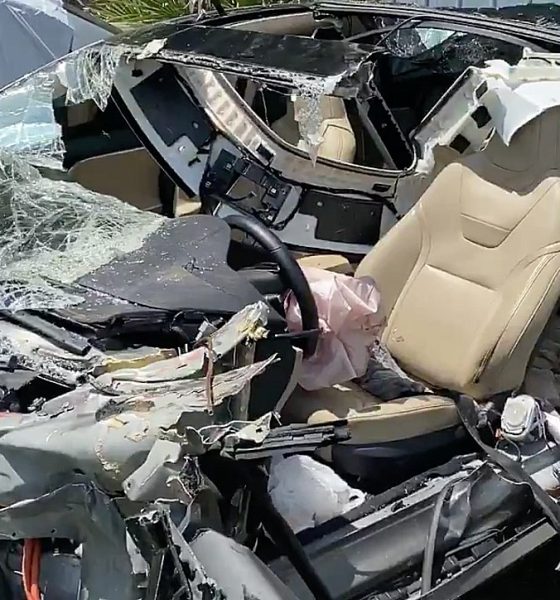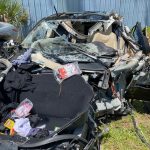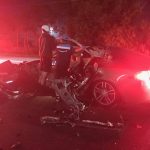

News
Tesla Model S shows 5-star safety rating in scary 18-wheeler accident
A Tesla Model S was destroyed after a collision with an 18-wheeler nearly tore the electric sedan to shreds. However, the two passengers inside escaped from the accident with some injuries, but their lives completely intact.
Reddit user u/quarm813 share photographs of his Model S P90D on Sunday, August 9, to the r/TeslaMotors subreddit. The incident occurred on Friday, July 31, the original poster said.
YouTuber Rich Rebuilds shared a video of the demolished electric car via his Twitter account.
https://twitter.com/RebuildsRich/status/1292776536630845440
According to u/quarm813, the Model S P90D was using Autopilot while navigating down the highway. However, when driving in the fast lane, an 18-wheeler swerved into the area of the road where the Tesla was driving.
The driver of the Tesla swerved to avoid contact with the tractor-trailer, but it was too late. “I grabbed the wheel and tried to avoid the 18 wheeler,” quarm said. “The rear guard rail on the 18 wheeler caught the front of the car and cut the entire driver-side off. The only way I can explain it is it looked like it was done with a lightsaber.”
Quarm indicated that they had suffered a severely broken arm that required multiple surgeries to repair. However, his focus was on his daughter, who was asleep at the time of the incident.
“My daughter was asleep in the rear seat. She got six stitches in her knee,” quarm indicated in a Reddit posting.
The severity of the accident can be seen in the numerous photographs that quarm shared with the r/TeslaMotors community.
- Credit: Reddit | u/quarm813
- Credit: Reddit | u/quarm813
Quarm indicated that both the passengers in the vehicle were able to walk away without emergency authorities using any sort of apparatuses, such as the Jaws of Life, to remove them from the car.
After the accident, quarm states that he was in the process of buying a new car, and that he was undecided between a Tesla Model S P100D or a Model Y. Ultimately, Tesla helped deliver the new electric vehicle to Quarm while he was still in the hospital.
“Did you know that Tesla will do a contactless delivery to the hospital? Tesla delivered a 2020 Y to the hospital for me,” he said.
Quarm indicated that they had ordered the car before arriving at the hospital, and Tesla had delivered it to the hospital because they had no other way to get home after receiving medical attention.
The survival of the two passengers is a testament to the safety of Tesla’s vehicles, especially the Model S.
Crash safety tests from the NHTSA have given the company’s flagship sedan a five-star rating in Overall Safety, Frontal and Side Crashes, and Rollover protection, putting it among one of the safest vehicles in its class.
The fact that two people emerged from the Model S with their lives is an incredible feat. Tesla vehicles have saved many lives over the years, but this could perhaps be the company’s most impressive feat to date.

Elon Musk
Elon Musk and Tesla AI Director share insights after empty driver seat Robotaxi rides
The executives’ unoccupied tests hint at the rapid progress of Tesla’s unsupervised Robotaxi efforts.

Tesla CEO Elon Musk and AI Director Ashok Elluswamy celebrated Christmas Eve by sharing personal experiences with Robotaxi vehicles that had no safety monitor or occupant in the driver’s seat. Musk described the system’s “perfect driving” around Austin, while Elluswamy posted video from the back seat, calling it “an amazing experience.”
The executives’ unoccupied tests hint at the rapid progress of Tesla’s unsupervised Robotaxi efforts.
Elon and Ashok’s firsthand Robotaxi insights
Prior to Musk and the Tesla AI Director’s posts, sightings of unmanned Teslas navigating public roads were widely shared on social media. One such vehicle was spotted in Austin, Texas, which Elon Musk acknowleged by stating that “Testing is underway with no occupants in the car.”
Based on his Christmas Eve post, Musk seemed to have tested an unmanned Tesla himself. “A Tesla with no safety monitor in the car and me sitting in the passenger seat took me all around Austin on Sunday with perfect driving,” Musk wrote in his post.
Elluswamy responded with a 2-minute video showing himself in the rear of an unmanned Tesla. The video featured the vehicle’s empty front seats, as well as its smooth handling through real-world traffic. He captioned his video with the words, “It’s an amazing experience!”
Towards Unsupervised operations
During an xAI Hackathon earlier this month, Elon Musk mentioned that Tesla owed be removing Safety Monitors from its Robotaxis in Austin in just three weeks. “Unsupervised is pretty much solved at this point. So there will be Tesla Robotaxis operating in Austin with no one in them. Not even anyone in the passenger seat in about three weeks,” he said. Musk echoed similar estimates at the 2025 Annual Shareholder Meeting and the Q3 2025 earnings call.
Considering the insights that were posted Musk and Elluswamy, it does appear that Tesla is working hard towards operating its Robotaxis with no safety monitors. This is quite impressive considering that the service was launched just earlier this year.
Elon Musk
Starlink passes 9 million active customers just weeks after hitting 8 million
The milestone highlights the accelerating growth of Starlink, which has now been adding over 20,000 new users per day.

SpaceX’s Starlink satellite internet service has continued its rapid global expansion, surpassing 9 million active customers just weeks after crossing the 8 million mark.
The milestone highlights the accelerating growth of Starlink, which has now been adding over 20,000 new users per day.
9 million customers
In a post on X, SpaceX stated that Starlink now serves over 9 million active users across 155 countries, territories, and markets. The company reached 8 million customers in early November, meaning it added roughly 1 million subscribers in under seven weeks, or about 21,275 new users on average per day.
“Starlink is connecting more than 9M active customers with high-speed internet across 155 countries, territories, and many other markets,” Starlink wrote in a post on its official X account. SpaceX President Gwynne Shotwell also celebrated the milestone on X. “A huge thank you to all of our customers and congrats to the Starlink team for such an incredible product,” she wrote.
That growth rate reflects both rising demand for broadband in underserved regions and Starlink’s expanding satellite constellation, which now includes more than 9,000 low-Earth-orbit satellites designed to deliver high-speed, low-latency internet worldwide.
Starlink’s momentum
Starlink’s momentum has been building up. SpaceX reported 4.6 million Starlink customers in December 2024, followed by 7 million by August 2025, and 8 million customers in November. Independent data also suggests Starlink usage is rising sharply, with Cloudflare reporting that global web traffic from Starlink users more than doubled in 2025, as noted in an Insider report.
Starlink’s momentum is increasingly tied to SpaceX’s broader financial outlook. Elon Musk has said the satellite network is “by far” the company’s largest revenue driver, and reports suggest SpaceX may be positioning itself for an initial public offering as soon as next year, with valuations estimated as high as $1.5 trillion. Musk has also suggested in the past that Starlink could have its own IPO in the future.
News
NVIDIA Director of Robotics: Tesla FSD v14 is the first AI to pass the “Physical Turing Test”
After testing FSD v14, Fan stated that his experience with FSD felt magical at first, but it soon started to feel like a routine.

NVIDIA Director of Robotics Jim Fan has praised Tesla’s Full Self-Driving (Supervised) v14 as the first AI to pass what he described as a “Physical Turing Test.”
After testing FSD v14, Fan stated that his experience with FSD felt magical at first, but it soon started to feel like a routine. And just like smartphones today, removing it now would “actively hurt.”
Jim Fan’s hands-on FSD v14 impressions
Fan, a leading researcher in embodied AI who is currently solving Physical AI at NVIDIA and spearheading the company’s Project GR00T initiative, noted that he actually was late to the Tesla game. He was, however, one of the first to try out FSD v14.
“I was very late to own a Tesla but among the earliest to try out FSD v14. It’s perhaps the first time I experience an AI that passes the Physical Turing Test: after a long day at work, you press a button, lay back, and couldn’t tell if a neural net or a human drove you home,” Fan wrote in a post on X.
Fan added: “Despite knowing exactly how robot learning works, I still find it magical watching the steering wheel turn by itself. First it feels surreal, next it becomes routine. Then, like the smartphone, taking it away actively hurts. This is how humanity gets rewired and glued to god-like technologies.”
The Physical Turing Test
The original Turing Test was conceived by Alan Turing in 1950, and it was aimed at determining if a machine could exhibit behavior that is equivalent to or indistinguishable from a human. By focusing on text-based conversations, the original Turing Test set a high bar for natural language processing and machine learning.
This test has been passed by today’s large language models. However, the capability to converse in a humanlike manner is a completely different challenge from performing real-world problem-solving or physical interactions. Thus, Fan introduced the Physical Turing Test, which challenges AI systems to demonstrate intelligence through physical actions.
Based on Fan’s comments, Tesla has demonstrated these intelligent physical actions with FSD v14. Elon Musk agreed with the NVIDIA executive, stating in a post on X that with FSD v14, “you can sense the sentience maturing.” Musk also praised Tesla AI, calling it the best “real-world AI” today.










